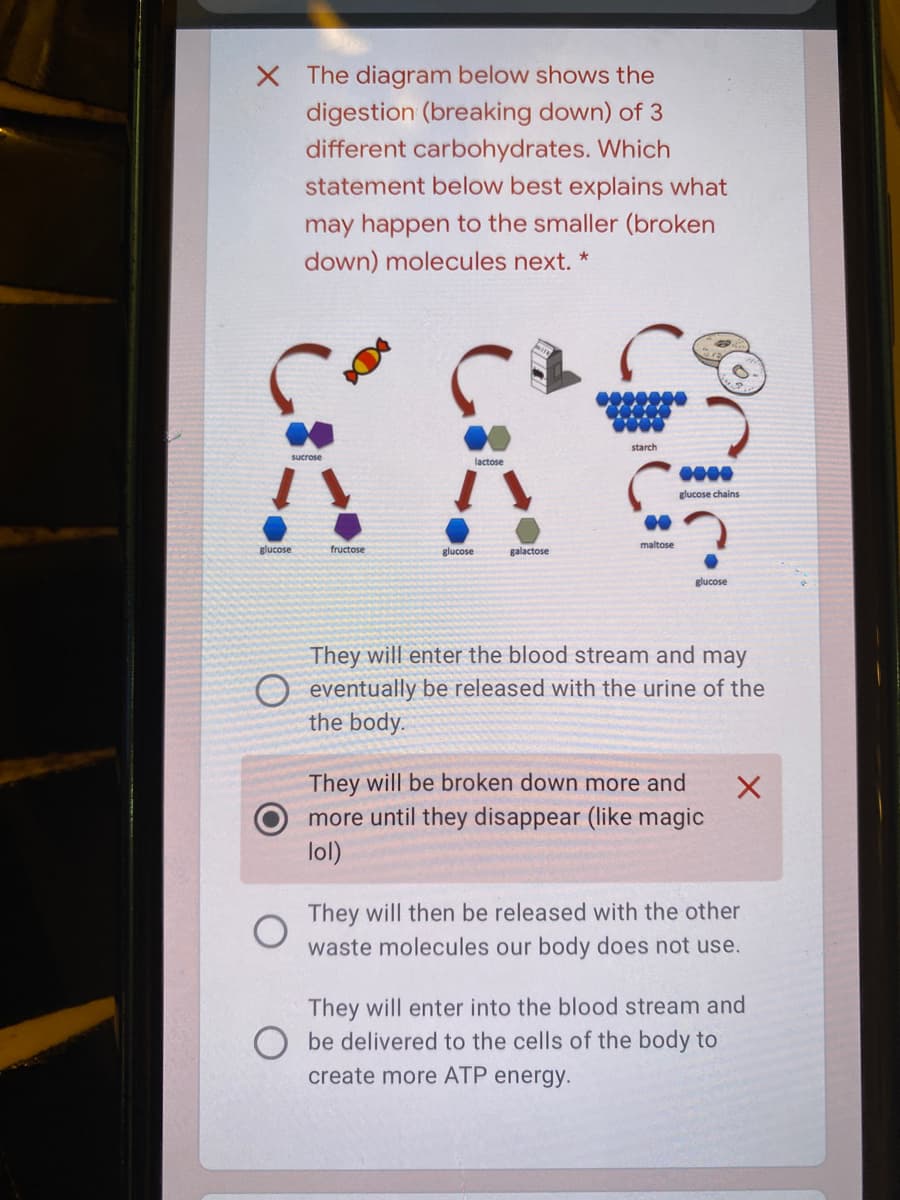X The diagram below shows the digestion (breaking down) of 3 different carbohydrates. Which statement below best explains what may happen to the smaller (broken down) molecules next. *
X The diagram below shows the digestion (breaking down) of 3 different carbohydrates. Which statement below best explains what may happen to the smaller (broken down) molecules next. *
Anatomy & Physiology
1st Edition
ISBN:9781938168130
Author:Kelly A. Young, James A. Wise, Peter DeSaix, Dean H. Kruse, Brandon Poe, Eddie Johnson, Jody E. Johnson, Oksana Korol, J. Gordon Betts, Mark Womble
Publisher:Kelly A. Young, James A. Wise, Peter DeSaix, Dean H. Kruse, Brandon Poe, Eddie Johnson, Jody E. Johnson, Oksana Korol, J. Gordon Betts, Mark Womble
Chapter23: The Digestive System
Section: Chapter Questions
Problem 1ILQ: By clicking on this link (http://openstaxcollege.org/l/fooddigestion) , you can watch a short video...
Related questions
Question
I chose the option b and I was told it was wrong why

Transcribed Image Text:X The diagram below shows the
digestion (breaking down) of 3
different carbohydrates. Which
statement below best explains what
may happen to the smaller (broken
down) molecules next. *
starch
sucrose
lactose
glucose chains
maltose
glucose
fructose
glucose
galactose
glucose
They will enter the blood stream and may
O eventually be released with the urine of the
the body.
They will be broken down more and
more until they disappear (like magic
lol)
They will then be released with the other
waste molecules our body does not use.
They will enter into the blood stream and
O be delivered to the cells of the body to
create more ATP energy.
Expert Solution
Step 1
A carbohydrate is an organic compound such as sugars, starches, celluloses and gums, that occurs in living tissues and food.
Trending now
This is a popular solution!
Step by step
Solved in 2 steps

Knowledge Booster
Learn more about
Need a deep-dive on the concept behind this application? Look no further. Learn more about this topic, biology and related others by exploring similar questions and additional content below.Recommended textbooks for you

Anatomy & Physiology
Biology
ISBN:
9781938168130
Author:
Kelly A. Young, James A. Wise, Peter DeSaix, Dean H. Kruse, Brandon Poe, Eddie Johnson, Jody E. Johnson, Oksana Korol, J. Gordon Betts, Mark Womble
Publisher:
OpenStax College

Health Safety And Nutrition F/Young Child
Health & Nutrition
ISBN:
9781305144767
Author:
MAROTZ
Publisher:
Cengage

Human Biology (MindTap Course List)
Biology
ISBN:
9781305112100
Author:
Cecie Starr, Beverly McMillan
Publisher:
Cengage Learning

Anatomy & Physiology
Biology
ISBN:
9781938168130
Author:
Kelly A. Young, James A. Wise, Peter DeSaix, Dean H. Kruse, Brandon Poe, Eddie Johnson, Jody E. Johnson, Oksana Korol, J. Gordon Betts, Mark Womble
Publisher:
OpenStax College

Health Safety And Nutrition F/Young Child
Health & Nutrition
ISBN:
9781305144767
Author:
MAROTZ
Publisher:
Cengage

Human Biology (MindTap Course List)
Biology
ISBN:
9781305112100
Author:
Cecie Starr, Beverly McMillan
Publisher:
Cengage Learning


Biology (MindTap Course List)
Biology
ISBN:
9781337392938
Author:
Eldra Solomon, Charles Martin, Diana W. Martin, Linda R. Berg
Publisher:
Cengage Learning
